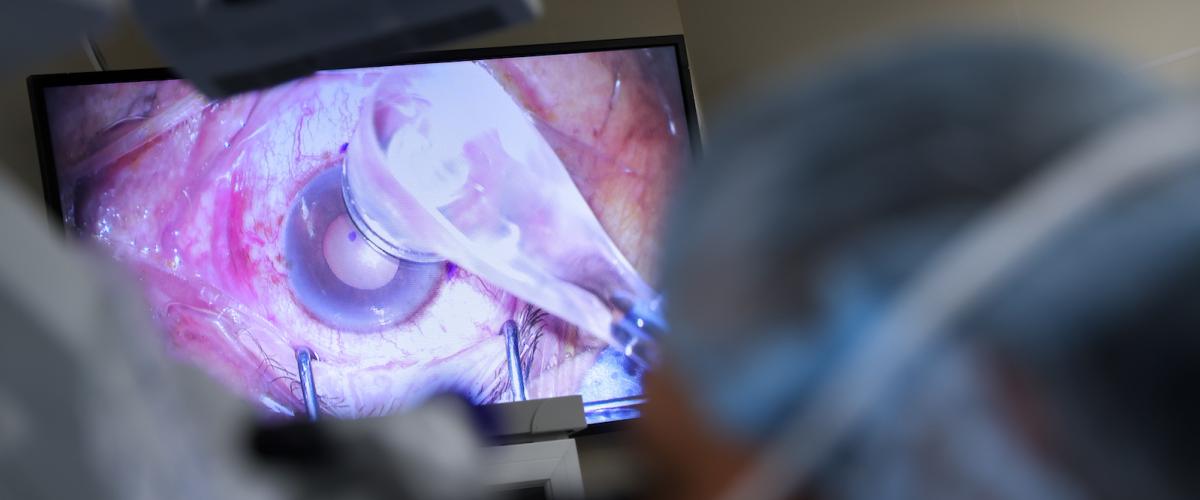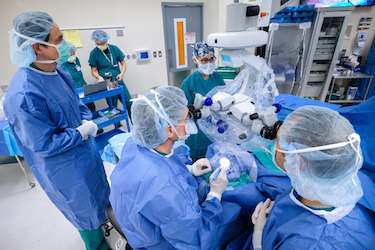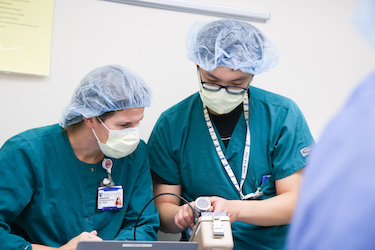
Junzo Chino, MD, a radiation oncologist and Duke’s director of brachytherapy, noted that Duke “treats several hundred patients with conventional eye plaques every year.”
But in June 2023, Duke became one of only three treatment sites in the U.S. certified to utilize a novel high dose-rate (HDR) yttrium-90 (Y-90) brachytherapy procedure. “Because of our wide referral base, some of our patients are not appropriate candidates for conventional eye plaques,” said Dr. Chino. “Those patients are the ones that may benefit from the Y-90 procedure.”

The Y-90 procedure, cleared by the Food and Drug Administration for episcleral brachytherapy of ocular tumors and benign growths, involves placing a disc of yttrium-90 on an applicator. This approach effectively treats small lesions from a variety of different diseases and conditions, including conjunctival squamous cell carcinomas, keloids and melanomas. Remarkably, most procedures are completed within five to 10 minutes.
“We’re honored to have been chosen as one of the first centers in the country to offer this innovation in patient care,” said Miguel Materin, MD, division chief of ocular oncology and ophthalmologist. “Y-90 is an incredibly less-invasive procedure that replaces traditional therapy and will positively contribute to the evolution of ocular oncology on a national scale.”
Treatment Benefits
When compared to a traditional eye plaque procedure in which the plaque is worn for multiple days, the benefits of the Y-90 procedure are astronomical. “There’s no need for the patient to admitted to the hospital or sent home with an active plaque in place, so it’s actually more cost-efficient than a traditional eye plaque,” said Dr. Chino. “It’s also a safer option, as it eliminates the uncertainty of having the patient in public with an active plaque.”
Another notable advantage of the Y-90 program is its ability to treat anterior lesions. Historically, limited radiation treatment options existed for patients with these lesions who had already completed chemotherapy and/or undergone conservative surgical measures because of the difficulty of suturing and positioning plaques on the anterior surface of the eye. “It’s a whole new avenue for patients with these small anterior lesions,” said Dr. Chino.
A Team Effort

In collaboration with the Duke Department of Ophthalmology, Dr. Chino has worked with Dr. Materin to successfully perform the Y-90 procedure on ten patients, with plans for more in the future.
During initial consults, patients are evaluated to determine whether they are a good fit for the Y-90 procedure. If so, using tumor measurements, the team calculates the time to the appropriate depth and then provides quality assurance during pre-planning. In the operating room, Dr. Chino attaches the Y-90 disc to the applicator, then delivers the source to the ophthalmologist. Physicists monitor the time as the source is applied. The procedure is over in a matter of minutes.
“All of brachytherapy is a team sport,” said Dr. Chino. “None of this happens without a high degree of collaboration between the surgeon, the radiation oncologist and a dedicated physics team, as well as the nurses, surgical coordinators, recovery staff and assistants in the operating room. Every role in this group is absolutely critical to ensure we’re on top of our game and each procedure is done as safely and effectively as possible.”
Expanding Horizons
Dr. Chino expects Duke’s Y-90 procedures to ramp up in the future, especially since larger disc sizes will be released soon, which will expand the number of patients who can benefit from this technology.
“We also expect the Y-90 procedure to grow in popularity because many of these patients, especially those with anterior plaques, have no other option except for radical surgery,” said Dr. Chino. “As our program continues to develop, and we publish on this and publicize our efforts, it will really allow for a development of a network of referring providers for these patients who have no other option.”
Article written by Sarah Brady, Vickie Frye and Tori Hall